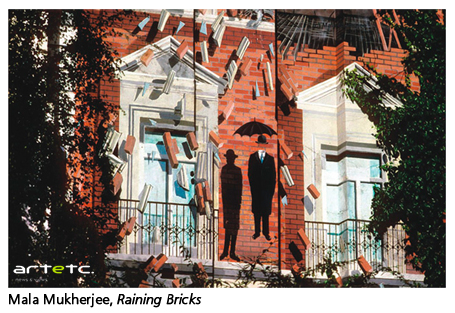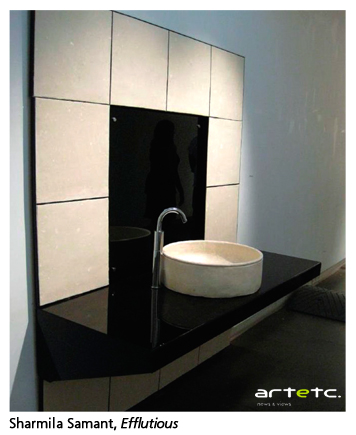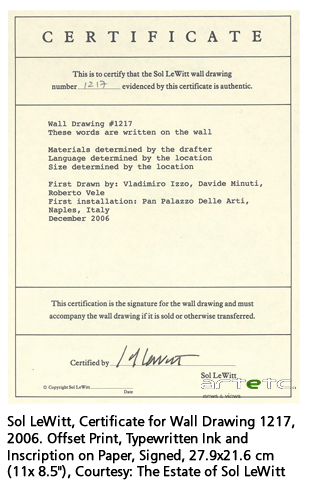- Publisher's Note
- Editorial
- The Enigma That was Souza
- Progressive Art Group Show: The Moderns
- The Souza Magic
- M.F. Husain: Other Identities
- From All, One; And From One, All
- Tyeb Mehta
- Akbar Padamsee: The Shastra of Art
- Sensuous Preoccupations of V.S. Gaitonde
- Manishi Dey: The Elusive Bohemian
- Krishen Khanna: The Fauvist Progressive
- Ram Kumar: Artistic Intensity of an Ascetic
- The Unspoken Histories and Fragment: Bal Chhabda
- P. A. G. and the Role of the Critics
- Group 1890: An Antidote for the Progressives?
- The Subversive Modernist: K.K.Hebbar
- Challenging Conventional Perceptions of African Art
- 40 Striking Indian Sculptures at Peabody Essex Museum
- Tibetan Narrative Paintings at Rubin Museum
- Two New Galleries for the Art of Asia opens at the Museum of Fine Arts in Boston
- Raphael, Botticelli and Titian at the National Gallery of Australia
- The Economics of Patronization
- And Then There Was Zhang and Qi
- What Happened and What's Forthcoming
- Random Strokes
- Yinka Shonibare: Lavishly Clothing the Somber History
- A Majestic “Africa”: El Anatsui's Wall Hangings
- The Idea of Art, Participation and Change in Pistoletto’s Work
- On Wings of Sculpted Fantasies
- The Odysseus Journey into Time in the Form of Art
- On Confirming the Aesthetic of Spectacle: Vidya Kamat at the Guild Mumbai
- Dhiraj Choudhury: Artist in Platinum Mode
- Emerging from the Womb of Consciousness
- Gary Hume - The Indifferent Owl at the White Cube, London
- Daum Nancy: A Brief History
- Experimenting with New Spatial Concepts – The Serpentine Gallery Pavilion Project
- A Rare Joie De Vivre!
- Art Events Kolkata-December 2011– January 2012
- Art Bengaluru
- Mumbai Art Sighting
- Delhi Dias
- Musings from Chennai
- Preview, February, 2012- March, 2012
- In the News-January 2012
ART news & views
Mumbai Art Sighting
Issue No: 25 Month: 2 Year: 2012
by Jasmine Shah Varma
Painterly gaze
 Piramal Art Gallery, a space dedicated to photography for several years hosted an exhibition of three photographers from January 5 to 12. Titled Sublime Chaos of Cities the collection featured the eminent photographer Mala Mukerjee alongside Smita Barooah Sanyal and Chandan Dubey. Their interest in capturing often overlooked aspects of cities, which nonetheless define them, brought this collection together. We were spared the clichéd city imagery instead offered a fresh perspective on the complexity and disorder we live in. All of them shared a knack to render a painterly feel to pure photography, elevating their work from mundane documentation. The collection was as much about the physical reality of places as the moods and atmosphere that these artists wanted to capture.
Piramal Art Gallery, a space dedicated to photography for several years hosted an exhibition of three photographers from January 5 to 12. Titled Sublime Chaos of Cities the collection featured the eminent photographer Mala Mukerjee alongside Smita Barooah Sanyal and Chandan Dubey. Their interest in capturing often overlooked aspects of cities, which nonetheless define them, brought this collection together. We were spared the clichéd city imagery instead offered a fresh perspective on the complexity and disorder we live in. All of them shared a knack to render a painterly feel to pure photography, elevating their work from mundane documentation. The collection was as much about the physical reality of places as the moods and atmosphere that these artists wanted to capture.
Mala Mukerjee seems to capture sounds, smells and colours of cities she travels to. There is calm and a balance in her city-scapes in spite of the heterogeneity marked by topographical lines, clashing textures and absurd happenstances. Mumbai based Chandan Dubey captures colourful fabrics of Jaipur that paint the city into vibrancy, or worn out walls of old concrete edifices in Goa, roof tops of a market in Hong Kong, or the ever-busy and captivating narrative waiting to be captured on the streets of Mumbai and Delhi. Singapore based Smita Barooah portrays a rich play of colours and abstract forms found in nooks and corners of the city. Her lens is drawn towards the bright and intense colours in our surroundings drawing our attention to splendor in chaos.
A world of people

Gurcharan Singh, the Mumbai based artist's solo show Twilight Tales opened at The Viewing Room gallery on January 12. Works on canvas and paper are on view until February 18. Continuing with his theme of people, animal and birds, this suite is a panorama of social behaviour, relationships and emotions. For a long time Singh has been keenly observing and portraying the human psyche. He depicts the personalities of all sorts of people that make this world - agreeable and displeasing, innocent and worldly wise. From middle class men and women to aristocrats, molls, children and the aged, he covers the human race with his skillful drawing, expressionist colour palette and clever compositions which create a wide perspective on the world we live in. However one is puzzled by Singh's penchant to depict characters that are from several centuries ago. While his paintings do have an aura of nostalgia one also observes a disconnect from the present world. His creations are an escape into a fictional universe.
Confronting the unexpected
 Sharmila Samant's exhibition Listen To Your Eye opened at Lakeeren Art Gallery on January 15. This solo in Mumbai came after a gap of 15 years. Her installations and sculptures dated 2012 continue to examine the effects of globalization, politics and corruption on ordinary people, and critique multinational corporations.
Sharmila Samant's exhibition Listen To Your Eye opened at Lakeeren Art Gallery on January 15. This solo in Mumbai came after a gap of 15 years. Her installations and sculptures dated 2012 continue to examine the effects of globalization, politics and corruption on ordinary people, and critique multinational corporations.
Viewing her works one is confronted with unexpected experiences: a speed breaker on the gallery floor and a potholed pathway made of real cobbled tiles. The play of words in the show title Listen to Your Eye is illustrated in a work made of neon lights where the form of an eye has an ear in the middle. The idea it appears is to get the viewer to do a double take and mull over the artist's concerns. The objects and material used evoke the idea of futility and incongruity. For instance in a life-size washbasin and wall tiles are made of soap that will wash away if used thus are not usable. In Shikishima, Yamato, Asahi, Yamazakur four hammers are made of glass so cannot be used for the known purpose. She titles each of these after names of Japanese units of Kamikaze pilots from World War II making references to futility of wars and sacrifices of men who fight for their country's agenda. And 'With the hardship of comfort' is a set of cushions and sofa with appealing floral patterns. It is rendered impractical towards its purpose of expected comfort because it's made of hard wood. Viewing Samant's work one is reminded of the Surrealists and Dadaists who aimed at subverting existing values and established ideas as in the work of Meret Oppenheim ('Object' fur covered cup and saucer). The exhibition concludes on February 6.
Art of certificates
 Samples of certificates of authenticity from the past 50 years by artists from the world over are on view at Mumbai Art Room until February 10. Art practices are no longer limited to two dimensional paintings on canvas and pedestal sculptures made of stone or metals. Over the years the definition of what constitutes art has moved to ready-mades, conceptual art, ephemeral art, performance art, text, audio, land art to touch upon just a few of the diverse practices and material used. Why is there a need to authenticate art? What function does authentication of an artist's own work perform? Does a certificate of authentication provide value to a work of art? How does one authenticate unconventional works of art that may not even be physically existent? These are few of the questions that come to mind viewing the samples of certificates in In Deed: Certificates of Authenticity in Art, a travelling show curated by Susan Hapgood and Cornelia Lauf. It features copies of certificates for works by artists such as Sol LeWitt, Marcel Duchamp, Robert Morris, Yoko Ono, George Brecht, Andrea Fraser, Robert Rauschenberg and, Indian artists including Sharmila Samant, Raqs Media Collective, Shreyas Karle and Hemali Bhuta.
Samples of certificates of authenticity from the past 50 years by artists from the world over are on view at Mumbai Art Room until February 10. Art practices are no longer limited to two dimensional paintings on canvas and pedestal sculptures made of stone or metals. Over the years the definition of what constitutes art has moved to ready-mades, conceptual art, ephemeral art, performance art, text, audio, land art to touch upon just a few of the diverse practices and material used. Why is there a need to authenticate art? What function does authentication of an artist's own work perform? Does a certificate of authentication provide value to a work of art? How does one authenticate unconventional works of art that may not even be physically existent? These are few of the questions that come to mind viewing the samples of certificates in In Deed: Certificates of Authenticity in Art, a travelling show curated by Susan Hapgood and Cornelia Lauf. It features copies of certificates for works by artists such as Sol LeWitt, Marcel Duchamp, Robert Morris, Yoko Ono, George Brecht, Andrea Fraser, Robert Rauschenberg and, Indian artists including Sharmila Samant, Raqs Media Collective, Shreyas Karle and Hemali Bhuta.
The show is an eye-opener as one is offered the privilege to see rare and important documents which provide a viewpoint to the functioning of business in the art world. The exhibition exposes the conundrum the art world faces; conceptual artists try to subvert the market forces through 'unobtainable' art objects which when nonetheless acquired by elite collectors become collectible and therefore part of the market force. There is nothing more reflective of the dominant forces of the market, with which artists have a love-hate relationship, than certificates of authenticity.
Indeed this show at Mumbai Art Room gets you thinking, even as some instances in it evoke humour, about the practice of authenticating works of art and the importance of the artist signature in the art world.